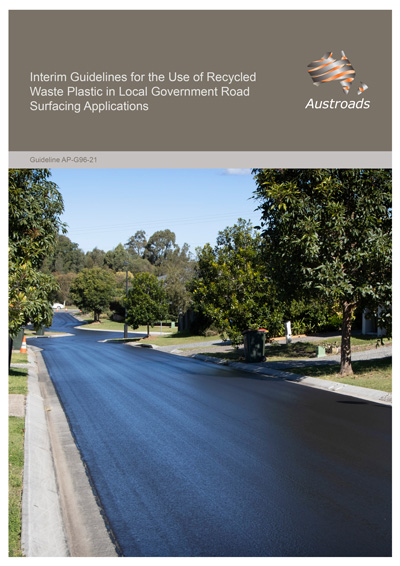Pavement

- Publication no: AP-G96-21
- ISBN: 978-1-922382-73-3
- Published: 14 July 2021
- PDF (free) Download
As a result of the ban on the export of recycled waste plastic, there is increasing interest in repurposing recycled waste plastic for use in road surfacing applications. There is no guide for this purpose and until such time as a guide is available there is a need for interim guidance about how recycled waste plastic could be used in road surfacing applications.
This document provides interim guidance on the types of recycled waste plastic in Australia, what it has been used for in recent times, how it could be incorporated into asphalt or sealing work and flowcharts to assist in procuring products that use recycled waste plastic for road surfacing applications.
The interim guidelines are intended for use by local governments for the surfacing of local roads that primarily provide access to abutting land. The guidance is applicable to roads that are not used by a heavy volume of traffic or a high proportion of heavy vehicles and where applicable have a design traffic loading of no more than 1 x 10^6 equivalent standard axles (ESAs) for a 20 year design period.
The interim guidelines offer no or limited guidance or technical information on health, safety or environmental matters, relative costs of products, procurement of proprietary products or performance of products being placed across Australia. Asset owners considering the use of recycled waste plastic in road surfacing applications will need to make their own assessment of the impacts of doing so, particularly for health, safety and environmental aspects including compliance with relevant state or federal legislation and how any adverse impacts can be mitigated or managed.
Watch the webinar, presented by Azeem Remtulla and Steve Halligan, to hear key information from the guidelines.
- Summary
- 1. Introduction
- 1.1 Purpose
- 1.2 Scope
- 1.3 Health Safety and Environment
- 1.4 Methodology
- 1.5 Deliverables
- 2. Literature Review and Findings
- 2.1 Literature and Reports Survey
- 2.2 Australian Research Work and Early Findings
- 2.2.1 Austroads
- 2.2.2 NACoE / WARRIP
- 2.3 Stakeholder Consultation
- 3. Technologies and Products
- 3.1 Types of Recycled Waste Plastic
- 3.2 Status on the Use of Recycled Waste Plastic
- 3.2.1 Placements in Australia and New Zealand
- 3.2.2 International Experience
- 4. Recycled Waste Plastic in Asphalt
- 4.1 Use of Recycled Waste Plastic in Asphalt
- 4.1.1 Terminology Used in Interim Guidelines
- 4.1.2 Applications
- 4.1.3 Mixing Processes
- 4.1.4 Typical Levels of Modification
- 4.2 Quality of Recycled Waste Plastic
- 4.3 Recycled Waste Plastic Modified Binders
- 4.3.1 Properties
- 4.3.2 Storage and Handling
- 4.4 Assessment of Recycled Waste Plastic Modified Asphalt
- 4.4.1 Properties of Recycled Waste Plastic Modified Asphalt
- 4.5 Alternative Asphalt Mix Design Process
- 4.6 Testing of Asphalt
- 4.6.1 Production Tolerances
- 4.6.2 Laboratory Practice
- 4.7 Manufacture, Storage and Transport of Asphalt
- 4.1 Use of Recycled Waste Plastic in Asphalt
- 5. Recycled Waste Plastic in Sprayed Sealing and Crack Sealing
- 5.1 Binder Properties, Storage and Use
- 5.2 Recycled Waste Plastic in Pavement Preservation Applications
- 6. Selection and Application
- 6.1 Procurement of Alternative Asphalt
- 6.1.1 Approval of an Alternative Asphalt Mix Design
- 6.1.2 Specification and Testing of Alternative Asphalt
- 6.1.3 Procurement of Alternative Asphalt
- 6.2 Procurement of Alternative Binder for Sprayed Sealing
- 6.1 Procurement of Alternative Asphalt
- 7. Conclusions
- References
- Appendix A Example Forms
- A.1 Form for Assessing Recycled Waste Plastic Binder Against PMB in Sprayed Seals
- A.2 Form for Assessing Recycled Waste Plastic Binder (Wet Process) Against PMB in Asphalt
- A.3 Form for Assessing Recycled Waste Plastic Binder (Wet Process) Against Bitumen in Sprayed Seals and Asphalt
- A.4 Form for Assessing Alternative Asphalt Against Conventional Asphalt
- A.5 Procurement Form for Alternative Asphalt
- A.6 Procurement Form for Alternative Binder for Sprayed Sealing
- Appendix B Examples of Completed Forms
- B.1 Example for Assessing Recycled Waste Plastic Binder Against PMB in Sprayed Seals
- B.2 Example for Assessing Recycled Waste Plastic Binder (Wet Process) Against PMB in Asphalt
- B.3 Example for Assessing Recycled Waste Plastic Binder (Wet Process) Against Bitumen in Sprayed Seals and Asphalt
- B.4 Example for Assessing Alternative Against Conventional Asphalt
- Appendix C Consultation List
- Appendix D Terminology
